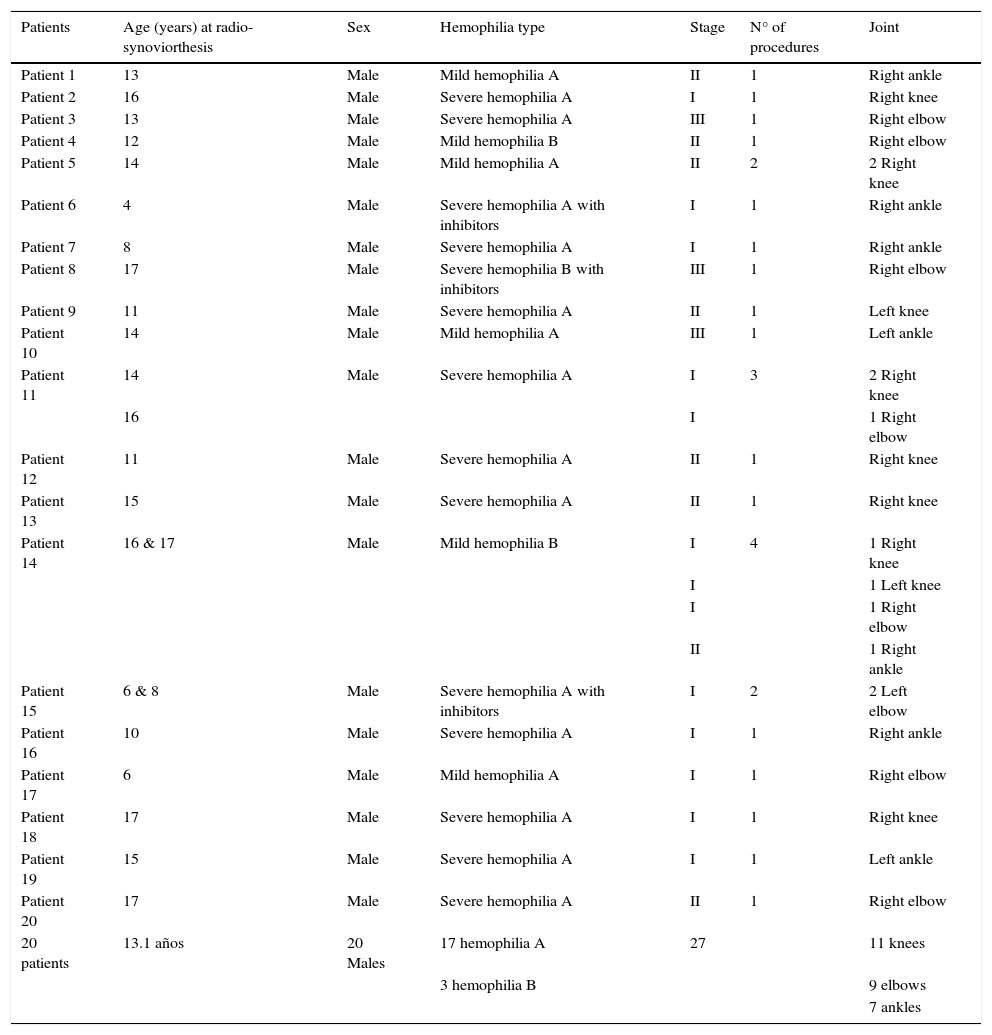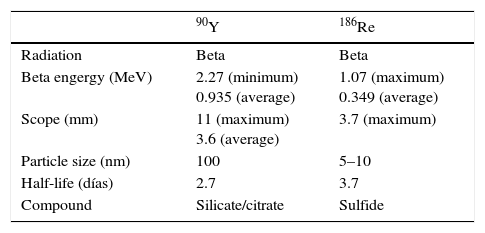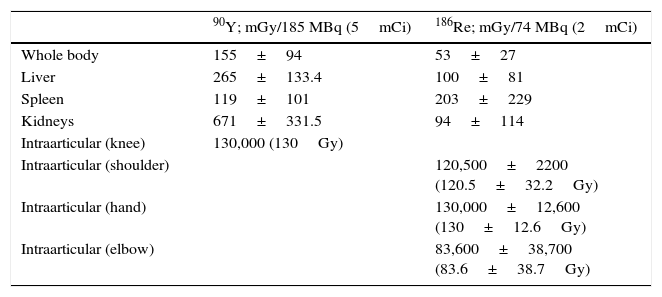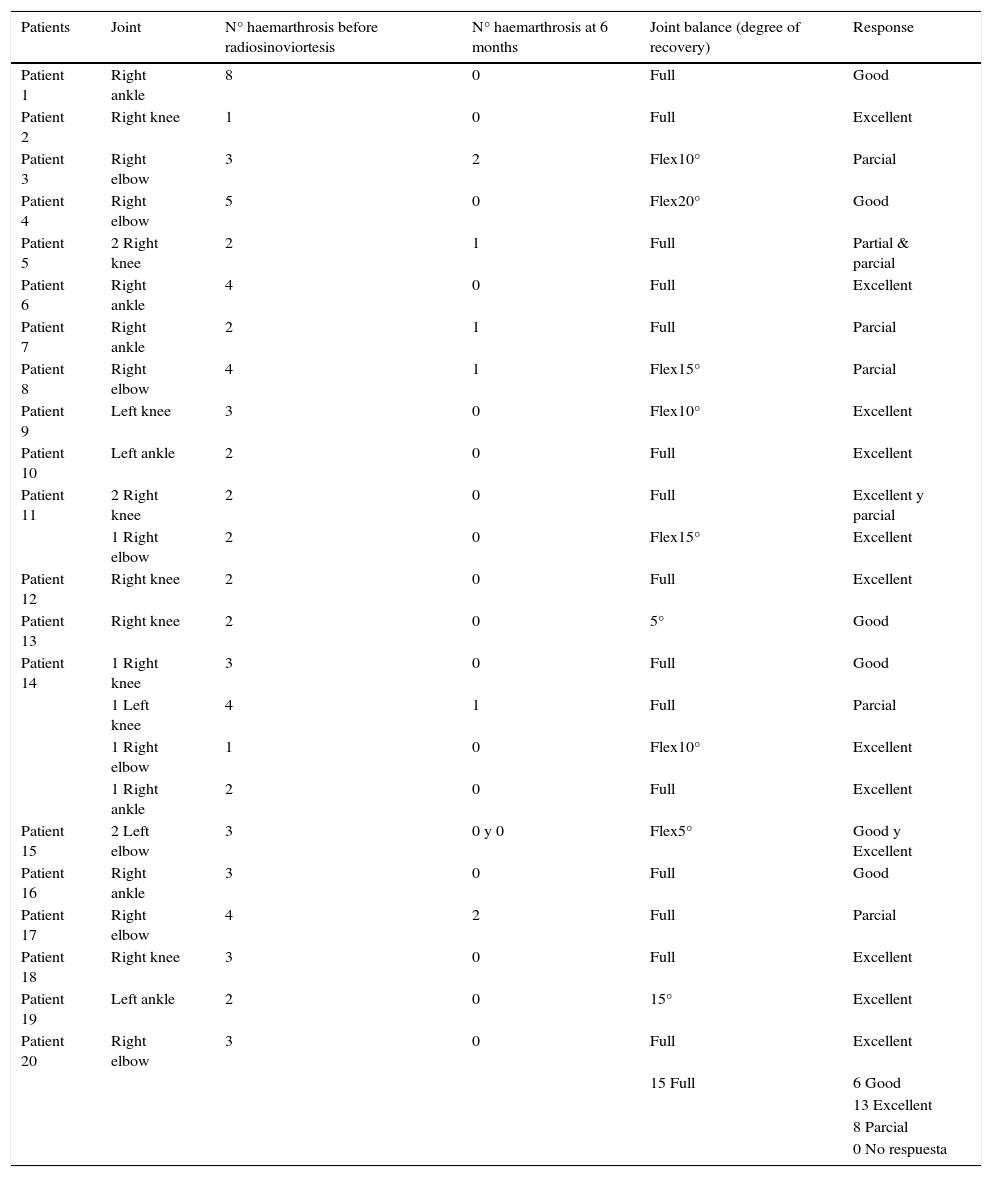To assess the outcome and adverse-effects of the radioisotope synoviorthesis in pediatric and adolescent patients with hemophilia.
Material and methodsProspective study of historical cohort was conducted. A total of 20 consecutive hemophiliacs with a mean age of 13.1 years (range 4–17) were included with a mean follow-up of 64.9 months (range 18–109). The diagnosis of synovitis was established on the basis of clinical follow-up including radiological images (radiography and/or MRI). For evaluation, the classification proposed by Fernandez-Palazzi was used. Inclusion criteria: Patients aged less than 18 years old with hemophilia and more than one haemarthrosis in less than 3 months remaining a chronic synovitis despite prophylactic therapy intensification. Exclusion criteria: Any contraindication for radionuclide synoviorthesis. Twenty-seven radioisotope synoviorthesis with 90Y-citrate-colloid and/or 186Re-sulphide-colloid were done. The effectiveness of the procedure was assessed through pre and posttreatment clinical comparison at 6 months after radioisotope synoviorthesis.
ResultsNineteen of the 27 synoviorthesis (70.3%) had a good or excellent response and 8 joints (29.7%) had partial response. It was necessary to repeat the procedure in 3 joints in 3 different patients, obtaining in all cases a good or excellent response. We appreciated inflammatory reaction after procedure in 4 cases (14.8%), which improved with analgesics and nonsteroidal anti-inflamatory drugs. None of the patients presented malignant or premalignant lesions during the follow-up.
ConclusionThe radionuclide synoviorthesis is a very effective procedure in pediatric and adolescent patients with hemophilia, being a minimally invasive procedure, easy to perform, safe and with minimal side effects.
Valorar la eficacia terapéutica y las complicaciones de la sinoviortesis radioisotópica observadas en pacientes en edad pediátrica y adolescentes con hemofilia.
Material y métodosEstudio prospectivo de cohorte histórica en el que se incluyó, de forma consecutiva, a 20 pacientes varones con hemofilia (edad media 13,1 años, rango: 4-17 años). El diagnóstico de sinovitis se estableció clínicamente y se confirmó por radiología simple o RM). Evaluación mediante la clasificación de Fernández-Palazzi. Criterios de inclusión: menores de 18 años de edad con hemofilia y más de un hemartros en menos de 3 meses, manteniéndose una sinovitis crónica a pesar de intensificar el tratamiento profiláctico. Criterios de exclusión: cualquier contraindicación para la realización de la sinoviortesis. Se realizaron 27 sinoviortesis radioisotópicas con citrato de 90Y colidal o sulfuro 186Re coloidal. La eficacia del procedimiento se evaluó a los 6 meses mediante comparación clínica pre- y postratamiento. Tiempo medio de seguimiento: 64,9 meses (rango 18-109 meses).
ResultadosEn 19 de las 27 sinoviortesis (70,3%) hubo una respuesta buena o excelente y en 8 articulaciones (29,7%), respuesta parcial. Se repitió el procedimiento en 3 articulaciones de 3 pacientes diferentes debido a la aparición de nuevo hemartros, obteniendo en todos los casos una respuesta buena o excelente. Apareció reacción inflamatoria postratamiento en 4 casos (14,8%), que mejoraron con tratamiento médico. No se observaron lesiones malignas ni premalignas durante el seguimiento.
ConclusiónLa sinoviortesis radioisotópica es un procedimiento efectivo, en pacientes en edad pediátrica y adolescentes con hemofilia, mínimamente invasivo, fácil de realizar, seguro y con complicaciones mínimas.
Article
If you experience access problems, you can contact the SEMNIM Technical Secretariat by email at secretaria.tecnica@semnim.es or by phone at +34 619 594 780.

Revista Española de Medicina Nuclear e Imagen Molecular (English Edition)











